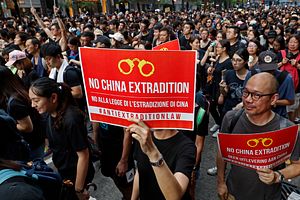The leader of China, it turns out, may not be all-powerful.
Faced with huge and disruptive protests in Hong Kong, Beijing blinked. The decision to shelve the legislation that sparked the demonstrations shows that limits still exist to how hard China can, or is willing to, push. It also exposed a fundamental contradiction in the “one country, two systems” framework that governs the semi-autonomous city.
Chinese President Xi Jinping has cemented his hold on power since taking the helm in 2012. His government has expanded control over information, religion, and other aspects of society. In Hong Kong, the local government has disqualified a pro-independence party, sent the leaders of a 2014 protest to prison, and denied a visa renewal to an editor for Britain’s Financial Times.
Activists decried these moves as chipping away at Hong Kong’s freedoms, but residents largely went about their lives. Then the government, with China’s backing, chipped too deeply, propelling hundreds of thousands, possibly millions in a city of 7.4 million people, into the streets.
For Xi, that apparently tipped the scales in a balancing act between attempts to tighten Communist authority and stability in the international financial center, and wanting to keep Hong Kong from slipping out of Beijing’s control — and even demanding independence.
“It is a sign that Xi Jinping’s government is not totally impervious to pressure, despite the fact that he has consolidated so much power,” said Ben Bland, an expert at the Lowy Institute in Australia and author of Generation HK: Seeking Identity in China’s Shadow.
It was in an atmosphere of uneasiness about China’s intentions that Carrie Lam, Hong Kong’s chief executive, proposed changes to extradition laws that would allow Hong Kong to send criminal suspects to mainland China to face trial. The Chinese government supported the proposals, though it insisted that the idea was Lam’s, not theirs.
The idea ignited simmering concern about Chinese influence and Hong Kong’s future. For many, the idea of being tried under the mainland legal system threw into question the “one country, two systems” framework under which the British returned Hong Kong to China in 1997. That concept guarantees the city’s right to retain its own social, legal, and political systems for 50 years.
It’s a framework that has been tested repeatedly in the ensuing two decades and stems from an intractable problem in China’s approach to Hong Kong. As China expert Kevin Carrico notes, the leader of Hong Kong is not elected democratically, as activists demand. Lam was chosen by a committee dominated by supporters of China’s ruling Communist Party. She is beholden to the Chinese government, not the people of Hong Kong.
So Lam persevered in her intention to push through the extradition bill despite a massive protest on June 9, and then clashes between police and demonstrators outside the legislature on Wednesday. She finally gave in on Saturday, but it was not enough to stop another huge protest on Sunday, whose turnout may have exceeded that of June 9. Lam has promised to suspend the bill; activists want it withdrawn entirely. Protesters on June 16 shouted out calls for Lam’s resignation.
Carrico, a senior lecturer in Chinese Studies at Monash University in Australia, called the protests a testament to a failure of Xi’s hard-line approach to Hong Kong. That includes a shift away from responding to or acknowledging the demands of protesters in Hong Kong, starting with the “Umbrella Movement” pro-democracy protests in 2014.
That doesn’t mean China will stop trying to control Hong Kong, as the balancing act continues.
“The Chinese government is determined to stop what it sees as the use of ‘two systems’ to undermine the unity of ‘one country,’ ” Bland said. “And Hong Kongers are clearly determined to fight for their freedoms.”
What is happening today in Hong Kong parallels what happened in 2003, when huge protests forced the government to drop a proposal to impose what opponents saw as a draconian national security law modeled on China’s.
Eventually, China’s then-hand-picked leader resigned, but the fundamental issue remained, and protests returned in 2012, 2014, and this year.
“There’s this constant cycle that is really a product of the way the chief executives of Hong Kong are elected,” Carrico said.
Xi and China may have beat a retreat, but the difference between what the two sides want suggests the pattern of government proposal and massive protest could well play out again in years to come.
Ken Moritsugu for The Associated Press. Associated Press writer Yanan Wang contributed to this story.

































